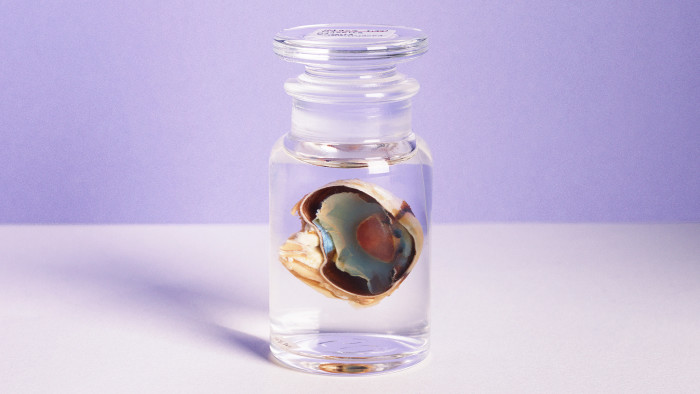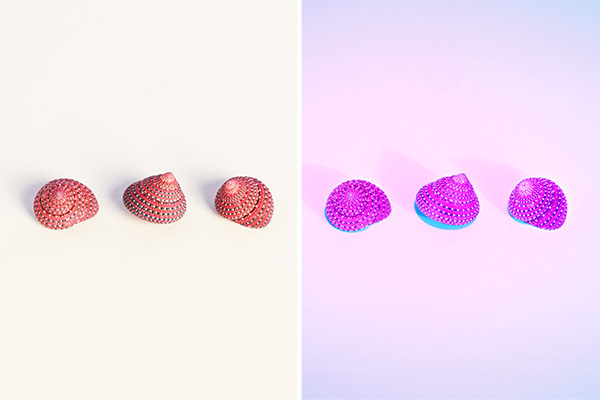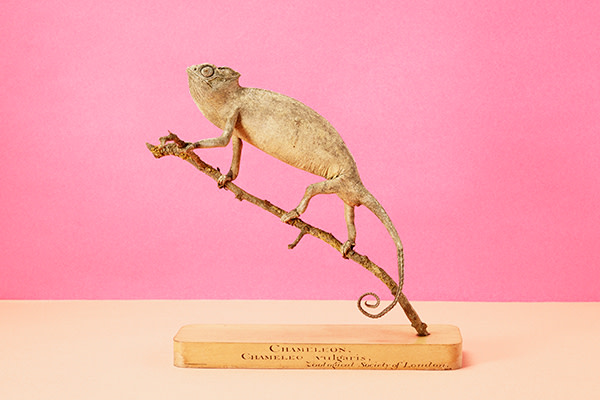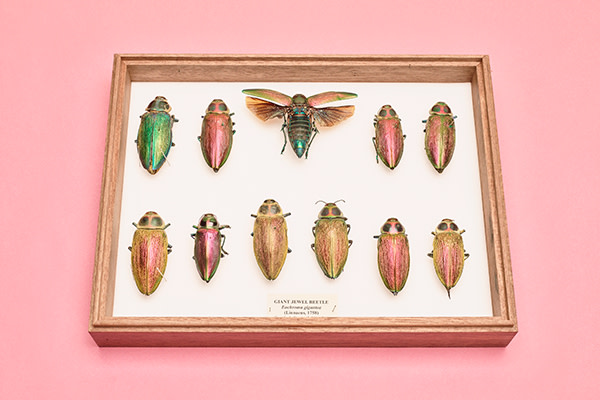The eyes have it: the evolution of vision

Simply sign up to the Life & Arts myFT Digest -- delivered directly to your inbox.
For Charles Darwin, vision posed the greatest conundrum in his theory of evolution. “To suppose that the eye, with all its inimitable contrivances, could have been formed by natural selection seems, I freely confess, absurd in the highest degree,” he wrote in On the Origin of Species, published in 1859. Visitors to the Natural History Museum in London may have similar feelings when they look at the eyes on display in its new exhibition, Colour and Vision. There are eyes on stalks, eyes in holes, eyes that work like cameras, compound eyes made of hundreds or even thousands of tiny eyelets, and many other ophthalmic variations.
“A complex and perfect” eye, Darwin asserted, could evolve from simpler forms through natural selection, and the exhibition illustrates this process, drawing on specimens from the museum’s rich fossil collection (supplemented by a few loans) as well as dazzling examples of the kaleidoscopic colours that animals and plants have evolved for those eyes to see. “Our key message is the link between the evolution of vision and colour,” says Fiona Cole-Hamilton, the exhibition’s developer. “Once the eye had evolved, colouration gave animals many benefits — as a warning, a camouflage or adornment to attract mates.”
The earliest exhibits date from the Ediacaran period, around 550 million years ago. Sandstone slabs show the fossilised traces of small worm-like animals burrowing on the sea floor. The directions of their tracks suggest that they had simple photoreceptor cells containing molecules sensitive to light, which could detect the shadow of another animal passing by or guide them to brightly lit areas where their microbial food sources were more likely to be found.

Then came the “Cambrian explosion” between 545 million and 530 million years ago, when the diversity of life increased more quickly than during any other period in Earth’s history. Palaeontologists believe that a key event, near the beginning of the period, was the evolution of the first proper eye. Genetic and biochemical modelling by Natural History Museum palaeontologists shows that the simple photoreceptor could have become an intricate and complex image-forming organ in less than 500,000 years, a blink of an eye in evolutionary history.
The flat patch of photosensitive cells would first have formed an indentation, or pit, which adds directional information; for instance, light coming in at a low angle hits cells on the opposite side of the pit while direct illumination affects all the cells. This tells the organism which direction light or shadow is coming from. The opening of the pit then narrows, providing stronger directional cues, while the photoreceptor cells morph into a primitive retina connected to an evolving optic nerve. Finally, the top of the pit is closed with a transparent membrane and a refractive lens forms beneath it, focusing incoming light on to the retina, providing detailed high-resolution vision.

Greg Edgecombe, a researcher at the museum into the evolution of vision, says the arrival of good eyesight was a key factor in the Cambrian explosion, provoking “a visual arms race between predators and prey”. As predators improved their vision for hunting, the hunted needed to see better to get out of their way, while evolving camouflage to make themselves inconspicuous.
Though all manner of animals emerged during this period, the dominant group of newcomers were trilobites, of which 21,000 species are known from the fossil record. Trilobites were the first creatures to develop sophisticated compound eyes that worked like those in insects today. Visitors to the exhibition will see some of the extraordinary diversity of eyes that evolved in trilobites before they died out at the end of the Permian period 250 million years ago. Asaphus had eyes on stalks, which might have enabled it to bury itself in the sandy seabed, with just its eyes sticking up to look for prey. Erbenochile had wraparound tower eyes, with rims around the top that may have acted as shades against strong sunlight. Walliserops was so heavily defended against predators that it even had nasty-looking spikes growing out of the top of its eyes.

We don’t know whether trilobites saw in colour but some fossils of very early fish certainly show evidence of doing so. The oldest is a fish called Cheiracanthus that lived 388 million years ago. Its eyes are preserved well enough to retain signs of the rod and cone cells that exist in the retina of all modern vertebrates with colour vision.
These ancient fish already have the same “camera eye” structure as subsequent vertebrates in the sea and later on land — reptiles, amphibians, birds and mammals — says David Gower, a scientist at the museum who works on vertebrate evolution. “The distinction between rods and cones is key to vertebrate vision,” he says. “The rods are far more sensitive to dim light and help us see at night, while the cones allow us to see in colour when the light is bright.” But the evolutionary story of vertebrate vision is not one of eyesight getting ever better. “There are always sensory trade-offs,” says Gower. “We don’t find organisms evolving all their sensory systems at the same time and becoming super-heroes, with every sense enhanced, because sensory tissue is expensive [for the body] to maintain and you tend to lose what you need least.”

This explains why most mammals except for primates have relatively poor colour vision. Ancestral mammals during the Jurassic period (around 150 million years ago) adopted a nocturnal lifestyle to escape the dominant daytime predators — dinosaurs. In the process, most of the colour-detecting cones in their eyes converted into light-sensitive rods, giving them superb night vision at the expense of being able to distinguish colours. The majority of mammals today are dichromats with just two types of cone; they see like people with red-green colour blindness. Humans and most other primates are trichromats with three types of cone, sensitive to blue, green and red light, which gives us broad-spectrum colour vision.

The genetic change responsible for primate colour vision is believed to have evolved in ancestral monkeys about 30 million years ago, says Anya Hurlbert, professor of visual neuroscience at Newcastle University. “It was a great advantage for the monkeys to be able to distinguish red fruit and berries from the green leaves of the trees in which they lived,” she says. “At the same time, it may have helped detect flushing of the skin on the face in response to mood changes.”
One of the highlights of the exhibition is the “wall of eyes”. It features 112 anatomical specimens from the National Eye Collection, which came to the museum in the 1970s from the Royal College of Surgeons ophthalmology department and is displayed here for the first time. The eyes are from different species of animal — not people, more squeamish visitors will be relieved to know — dissected and preserved in alcohol in glass jars. The origins of the collection are unclear, says Mary Spencer Jones, the curator who looks after it, though the specimens are clearly many decades old. “They have lost most of their original colour through the preservation process,” she says. “But everyone who looks at them is fascinated — for example to see the long optic nerve coming into the back of the eye.” To make up for the colourlessness of the preserved eyes, the wall will also feature vivid images of living eyes of animals and people. Visitors can also add their own eyes to the digital screens on the wall via social media.

. . .
The second part of the exhibition looks at the colours that nature has evolved for those eyes to see. The problem here, as Cole-Hamilton concedes, is that the museum decided not to include any live animals or plants in the show — and preserved specimens, whether fossils or modern, rarely keep the full colouration they had in life.
There are two categories of colour in living creatures: pigments (chemistry) and structural colour (physics). Pigments are produced in the organism’s outer layer through biochemical reactions. Structural colour results from microscopic physical patterns on the surface, which interfere with incoming light through diffraction and other optical processes; some bird feathers and butterfly wings show particularly vivid structural colour.

Pigment colouration does not change with the angle of viewing, unlike structural colour, but the chemicals responsible often break down rapidly after death while structural colour is more resilient. Indeed, the physical patterns occasionally survive fossilisation, as the exhibition’s 47 million-year-old beetles from Messel in Germany show. They are remarkably similar to scarab and jewel beetles alive today.

Although chemists know of hundreds of biological pigments, from carotenoids and melanins to flavonoids and anthocyanins, much work still needs to be done to identify the sources of colour in particular organisms. “We know very little about the colouration of marine molluscs — sea shells,” says Suzanne Williams, a researcher who is working to fill the gap. Her latest research at the museum shows that porphyrin pigments, similar to those implicated in the human metabolic disorder porphyria (one of the symptoms of which is that skin is very sensitive to light), play the key role in producing the red, pink and orange colours in marine snails. Though organic pigments in shells rarely survive fossilisation, they occasionally leave traces that are invisible in normal light but fluoresce in ultraviolet light, she adds.
Sometimes pigments and structural colours work together, particularly in birds. Take the rose-ringed parakeet. It is usually green, a combination of yellow pigmentation and blue structural colour, but mutations have produced strains that show only blue or yellow colouration.

The peacock mantis shrimp, which lives in rocky crevices in shallow waters of the Pacific and Indian oceans, sports every colour in and beyond the rainbow, from its iridescent blue-green back to its scarlet legs. A range of pigments and surface effects create its multihued appearance, which is related to its remarkable eyesight. Because it can see so many colours, the shrimp uses them to display territorial and sexual messages to rivals and would-be mates. Its eyes contain a record-breaking 16 different types of optical sensor, including ones that detect polarised and ultraviolet light, compared with three types in people.

“Although we have no live animals, we thought about making an exception for the mantis shrimp,” says Cole-Hamilton, “but we decided not to because it would hide away for long periods and visitors would be disappointed.” Instead, they will see a virtual reality show including a view of what the world might look like through the eyes of a mantis shrimp.
How the animals themselves really perceive these colours is impossible for us to imagine, says Hurlbert. “All impressions of colour and vision are subjective. We humans have an aesthetic and cultural response to colour that would not apply in any other species,” she says.
‘Colour and Vision: Through the Eyes of Nature’, is at the Natural History Museum, London SW7 5BD, sponsored by LG OLED TV, from July 15 to November 6, nhm.ac.uk/colourandvision
Photographs: Felicity McCabe
Comments